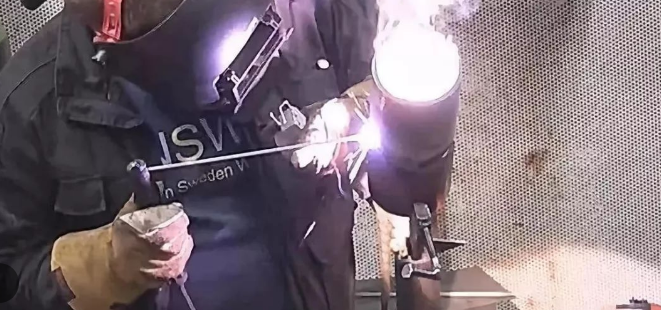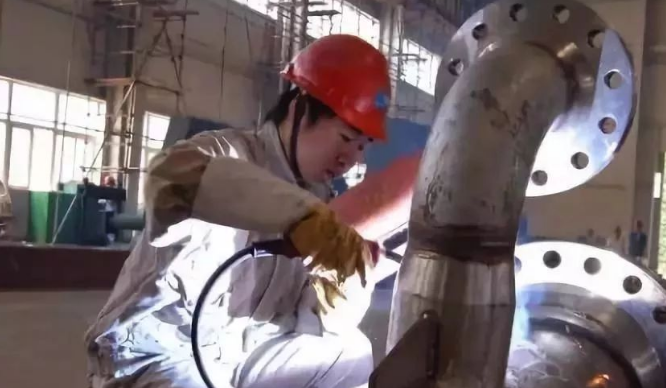How to weld high carbon steel
How to weld high carbon steel
High carbon steel refers to carbon steel with carbon element higher than 0.6%. It has greater hardening tendency than medium carbon steel, and forms high carbon martensite, which is more sensitive to the formation of cold cracks. At the same time, the martensite structure formed in the heat affected zone of welding is hard and brittle, which leads to the greatly reduced plasticity and toughness of the joint. Therefore, the weldability of high carbon steel pipe is quite poor. Special welding process must be adopted to ensure the performance of the joint. Therefore, it is seldom used in welding structure. High carbon steel is mainly used for machine parts requiring high hardness and wear resistance, such as shaft, large gear and coupling [1]. In order to save steel and simplify the processing technology, these machine parts are often combined by welding structure. In the manufacturing of heavy machinery, there are also welding problems of high carbon steel parts. When developing the welding process of high carbon steel weldment, it is necessary to analyze all kinds of possible welding defects and take corresponding welding process measures.

1.1 welding method
High carbon steel is mainly used for structures with high hardness and wear resistance, so the main welding methods are arc welding, brazing and submerged arc welding.
1.2 welding materials
High carbon steel welding generally does not require equal strength of joint and base metal. In general, low hydrogen electrode with strong sulfur removal ability, low diffusible hydrogen content of deposited metal and good toughness is used in arc welding. When the strength of weld metal and base metal is required, the low hydrogen electrode of corresponding level shall be selected; when the strength of weld metal and base metal is not required, the low hydrogen electrode with strength level lower than that of base metal shall be selected, and the electrode with strength level higher than that of base metal shall not be selected. If preheating of the base metal is not allowed during welding, in order to prevent cold cracks in the heat affected zone, austenitic stainless steel electrode can be selected to obtain austenitic structure with good plasticity and strong crack resistance.
1.3 groove preparation
In order to limit the carbon content in the weld metal and reduce the fusion ratio, U-groove or V-groove is generally used during welding, and the oil stain and rust within 20 mm on both sides of the groove and groove shall be cleaned.
1.4 preheating
When the structural steel electrode is used for welding, it must be preheated before welding, and the preheating temperature shall be controlled within 250 ℃ ~ 350 ℃.
1.5 interlayer treatment
In multi-layer and multi pass welding, the first pass is welded with small diameter electrode and low current welding. Generally, the workpiece is placed in the semi vertical welding or the electrode is used to swing horizontally, so that the whole heat affected zone of the base metal is heated in a short time, so as to obtain preheating and heat preservation effect.
1.6 post weld heat treatment
Put the workpiece into the heating furnace immediately after welding, conduct heat preservation at 650 ℃ for stress relief annealing [3].

2.1 prevention measures for hot cracks
1) control the chemical composition of the weld, strictly control the content of sulfur and phosphorus, and appropriately increase the content of manganese to improve the weld structure and reduce segregation.
2) control the section shape of the weld, and the width depth ratio should be slightly larger to avoid the segregation of the weld center.
3) for weldments with large rigidity, proper welding parameters, welding sequence and direction shall be selected.
4) if necessary, preheating and slow cooling measures shall be taken to prevent hot cracks.
5) increase the basicity of the electrode or flux to reduce the impurity content in the weld and improve the degree of segregation.
2.2 prevention measures for cold cracks
1) preheating before welding and slow cooling after welding can not only reduce the hardness and brittleness of the heat affected zone, but also accelerate the outward diffusion of hydrogen in the weld.
2) select appropriate welding measures.
3) proper assembly and welding sequence shall be adopted to reduce the restraint stress of welding joint and improve the stress state of weldment.
4) select appropriate welding materials, dry the welding rod and flux before welding, and use them as you choose.
5) before welding, the water, rust and other dirt on the basic metal surface around the groove shall be carefully removed to reduce the diffusible hydrogen content in the weld.
6) hydrogen removal shall be carried out immediately before welding to make hydrogen fully escape from the welded joint.
7) the annealing treatment of stress relief shall be carried out immediately after welding to promote the hydrogen in the weld to spread out.
High carbon steel refers to carbon steel with carbon element higher than 0.6%. It has greater hardening tendency than medium carbon steel, and forms high carbon martensite, which is more sensitive to the formation of cold cracks. At the same time, the martensite structure formed in the heat affected zone of welding is hard and brittle, which leads to the greatly reduced plasticity and toughness of the joint. Therefore, the weldability of high carbon steel pipe is quite poor. Special welding process must be adopted to ensure the performance of the joint. Therefore, it is seldom used in welding structure. High carbon steel is mainly used for machine parts requiring high hardness and wear resistance, such as shaft, large gear and coupling [1]. In order to save steel and simplify the processing technology, these machine parts are often combined by welding structure. In the manufacturing of heavy machinery, there are also welding problems of high carbon steel parts. When developing the welding process of high carbon steel weldment, it is necessary to analyze all kinds of possible welding defects and take corresponding welding process measures.

1 weldability of high carbon steel
1.1 welding method
High carbon steel is mainly used for structures with high hardness and wear resistance, so the main welding methods are arc welding, brazing and submerged arc welding.
1.2 welding materials
High carbon steel welding generally does not require equal strength of joint and base metal. In general, low hydrogen electrode with strong sulfur removal ability, low diffusible hydrogen content of deposited metal and good toughness is used in arc welding. When the strength of weld metal and base metal is required, the low hydrogen electrode of corresponding level shall be selected; when the strength of weld metal and base metal is not required, the low hydrogen electrode with strength level lower than that of base metal shall be selected, and the electrode with strength level higher than that of base metal shall not be selected. If preheating of the base metal is not allowed during welding, in order to prevent cold cracks in the heat affected zone, austenitic stainless steel electrode can be selected to obtain austenitic structure with good plasticity and strong crack resistance.
1.3 groove preparation
In order to limit the carbon content in the weld metal and reduce the fusion ratio, U-groove or V-groove is generally used during welding, and the oil stain and rust within 20 mm on both sides of the groove and groove shall be cleaned.
1.4 preheating
When the structural steel electrode is used for welding, it must be preheated before welding, and the preheating temperature shall be controlled within 250 ℃ ~ 350 ℃.
1.5 interlayer treatment
In multi-layer and multi pass welding, the first pass is welded with small diameter electrode and low current welding. Generally, the workpiece is placed in the semi vertical welding or the electrode is used to swing horizontally, so that the whole heat affected zone of the base metal is heated in a short time, so as to obtain preheating and heat preservation effect.
1.6 post weld heat treatment
Put the workpiece into the heating furnace immediately after welding, conduct heat preservation at 650 ℃ for stress relief annealing [3].
2. Welding defects of high carbon steel and preventive measures
Due to the high hardening tendency of high carbon steel, hot cracks and cold cracks are easy to appear during welding.
2.1 prevention measures for hot cracks
1) control the chemical composition of the weld, strictly control the content of sulfur and phosphorus, and appropriately increase the content of manganese to improve the weld structure and reduce segregation.
2) control the section shape of the weld, and the width depth ratio should be slightly larger to avoid the segregation of the weld center.
3) for weldments with large rigidity, proper welding parameters, welding sequence and direction shall be selected.
4) if necessary, preheating and slow cooling measures shall be taken to prevent hot cracks.
5) increase the basicity of the electrode or flux to reduce the impurity content in the weld and improve the degree of segregation.
2.2 prevention measures for cold cracks
1) preheating before welding and slow cooling after welding can not only reduce the hardness and brittleness of the heat affected zone, but also accelerate the outward diffusion of hydrogen in the weld.
2) select appropriate welding measures.
3) proper assembly and welding sequence shall be adopted to reduce the restraint stress of welding joint and improve the stress state of weldment.
4) select appropriate welding materials, dry the welding rod and flux before welding, and use them as you choose.
5) before welding, the water, rust and other dirt on the basic metal surface around the groove shall be carefully removed to reduce the diffusible hydrogen content in the weld.
6) hydrogen removal shall be carried out immediately before welding to make hydrogen fully escape from the welded joint.
7) the annealing treatment of stress relief shall be carried out immediately after welding to promote the hydrogen in the weld to spread out.
3 Summary
Due to high carbon content, high hardenability and poor weldability of high carbon steel, it is easy to produce high carbon martensite structure and welding cracks during welding. Therefore, when welding high carbon steel, it is necessary to reasonably select welding process and take corresponding measures in time to reduce the occurrence of welding cracks and improve the performance of welding joints.
